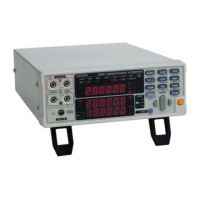95
8.1 Overview and Features
This chapter describes the GP-IB and RS-232C interfaces, using the
following symbols to indicate which information pertains to each
interface. Sections with neither of these symbols pertain to both
interfaces.
: GP-IB only
: RS-232C only
Before Use • Always make use of the connector screws to affix the GP-IB or RS-
232C connectors.
• When issuing commands that contain data, make certain that the
data is provided in the specified format.
All instrument functions other than power on/off switching can be
controlled via GP-IB/RS-232C interfaces.
• Resetting is supported.
• IEEE 488.2-1987 Common (essential) Commands are supported.
• Complies with the following standard:
Applicable standard IEEE 488.1-1987
*1
• This instrument is designed with reference to the following standard:
Reference standard IEEE 488.2-1987
*2
• If the output queue becomes full, a query error is generated and the
output queue is cleared. Therefore, clearing the output queue and
query error output from the deadlocked condition
*3
as defined in
IEEE 488.2 is not supported.
RS-232C/GP-IB
Interfaces Chapter 8
8.1 Overview and Features
*1. ANSI/IEEE Standard 488.1-1987, IEEE Standard Digital Interface for
Programmable Instrumentation.
*2. ANSI/IEEE Standard 488.2-1987, IEEE Standard Codes, Formats,
Protocols, and Common Commands.
*3. The situation in which the input buffer and the output queue become full,
so that processing cannot continue.
While carrying out temperature measurement via the RS-232C
interface, the RS-232C/GP-IB communication functions are not
available.
❖ Temperature measurement via RS-232C interface (using the 3444/3445
TEMPERATURE HiTESTER+ 3909 INTERFACE PACK) (Page 34)

